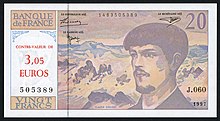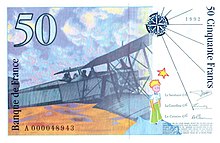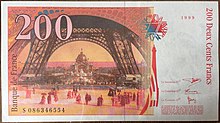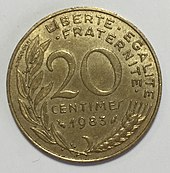French Franc
| French Franc | |
|---|---|
| Country: |
|
| Subdivision: | 100 centimes |
| ISO 4217 code : | FRF |
| Abbreviation: | Fri, F, FF |
|
Exchange rate : (fixed) |
1 EUR = 6.55957 FRF |
The franc / fʁɑ̃ / (German officially franc , but hardly used - probably also in order not to confuse it with the Swiss franc ) is the former currency of France . In addition, the franc was legal tender in Andorra and in Monaco it circulated parallel to the Monegasque franc .
The sub-unit is the centime [sɑ̃tˈiːm] (abbreviation c ); 100 centimes make one franc.
Currency symbol and abbreviation
The currency symbol is "Fr". Common abbreviations are F, FF for franc français or according to ISO 4217 FRF.
A currency symbol " ₣ " ( "F" with an additional lower cross-bar , Unicode U + 20A3 french franc sign ) was 1988 by Edouard Balladur (at the time of State in the Economy and Finance ) suggested but not accepted.
history
On December 5, 1360, the first gold coins called Francs by the people were introduced. They carried a portrait of King John II with the inscription Johannes Dei Gratia Francorum Rex (John by the grace of God, King of the Franks ), from whose penultimate word the name was rubbed off.
The franc was introduced as the national currency on April 7, 1795 as the successor to the livre and was divided into decimal numbers.
With the Latin Monetary Union in 1865, it spread throughout Europe, and in many former French colonies the currency denomination is still the franc today . The same applied to Belgium (franc belge, Belgian franc ) and Luxembourg until the euro was introduced .
It was the first pure decimal currency in Europe. This system had a huge impact on currencies in other countries. The exchange rate against the Goldmark determined in the context of the gold standard was 0.81 M.
During the Second World War , the exchange rate was 1 Reichsmark = 20 Francs.
After the Second World War
There was no currency reform in France after World War II. The country participated in the Bretton Woods system , a system of largely rigid exchange rates that existed from 1945 to 1973.
In 1945 the FF started with an exchange rate of 480 FF for 1 British pound and 119.1 FF for 1 US dollar . In 1949 the rate was 980: 1 or 350: 1.
In 1957 and 1958 the FF was devalued again (1382.3: 1 and 493.7: 1; 1 FF was worth 1.8 mg of gold): in August 1957 by 16 2/3%. As in all countries participating in the Bretton Woods system, there was also considerable inflation in France:
- Goods that cost 100 francs in France in 1950 cost an average of 172 francs ten years later;
- Goods that cost 100 francs in 1960, ten years later averaged 151 francs.
Due to inflation, the prices had got an unwieldy number of zeros. After Charles de Gaulle came back to power in June 1958 , he commissioned Antoine Pinay and Jacques Rueff to create a "franc lourd" (literally: heavy franc ). At the same time the franc depreciated by 17.5%; this was the seventh devaluation since the liberation in 1944. On December 27, 1958, the introduction of the Nouveau Franc (NF) on January 1, 1960 was decreed. A NF , officially only called Franc (F) since 1963, corresponded to 100 old Francs ( anciens francs ). The old franc coins could continue to be used as centimes. In everyday language, the specification in old francs remained in use for decades.
President de Gaulle announced in early 1968 that the franc was "as good as gold". For years he trained Great Britain because of its frequent currency difficulties and in 1967 refused to help the British pound . From the end of October 1968 the franc got into trouble. There was a run on the Deutsche Mark. Der Spiegel reported:
“Within a few months, inflation in France reached a rate of ten percent. Despite powerful export subsidies, there was already a gap of 4.4 billion francs in the trade balance at the end of October. The currency reserves are even worse. Since the workers and students uprising in May, the Banque de France has lost 10.6 billion marks in gold and foreign currency - almost 40 percent of the holdings that de Gaulle has gathered over the years. "
De Gaulle and other decision-makers, including Prime Minister Couve de Murville , decided against devaluing the franc and in favor of rigorous currency management . In August 1969, the new French government ( Chaban-Delma's cabinet ) decided to devalue the franc by eleven percent.
In the Smithsonian Agreement of December 1971, the exchange rate of the franc to gold remained the same; as the DM and the yen appreciated against gold by 4.6 and 7.7% respectively and the US dollar depreciated by 7.9%, the parity of the franc against these currencies changed.
In 1973/74 and 1979/80 two oil crises exacerbated the already high inflation. As in other countries, there was stagflation . In March 1973 the foreign exchange exchanges in the industrialized countries closed for two weeks. Six of the then nine countries of the European Community - the Federal Republic of Germany, France, Denmark and the Benelux countries - decided to block floating their currencies . Within the bloc there were fixed currency parities with ranges of ± 2.25% each. The other three EC countries - Italy, Great Britain and Ireland - decided to let the rates of their currencies float freely.
Another turning point was the presidency of François Mitterrand , which lasted from mid-1981 to May 1995 . In the early 1980s , France nationalized numerous companies and introduced the 39-hour week; much of the nationalizations were reversed in the mid-1980s. In the course of the reunification sought by Germany in 1989/90 , Mitterrand linked France's approval with the approval of Federal Chancellor Helmut Kohl for the "deepening of the economic and monetary union". This meant the creation of a common European currency.
The Maastricht Treaty was ratified on February 7, 1992 . Mitterrand's successor Jacques Chirac implemented the introduction of the euro . On January 1, 1999, the rates of the currencies of all countries participating in the euro - including the rate of the FF - were fixed; From then on, the central banks calculated and reported in euros. The FF rate was 6.55957 F = € 1.
On the 20-franc banknotes of 1997, the red additional imprint "Contre-de Valeur 3, was later sometimes in white watermark field 05 Euros" (the equivalent of 3, 05 euros) made to facilitate the changeover.
Until 1990 the FF was also a small reserve currency :
| 1970 | 1980 | 1990 | 2000 | 2001 | 2002 | 2003 | 2004 | 2005 | 2006 | 2007 | 2008 | 2009 | 2010 | 2011 | 2012 | 2013 | 2014 | 2015 | 2016 | 2017 | 2018 | 2019 | ||||||||
|---|---|---|---|---|---|---|---|---|---|---|---|---|---|---|---|---|---|---|---|---|---|---|---|---|---|---|---|---|---|---|
| USD | 77.2 | 67.2 | 62.8 | 70.5 | 70.7 | 66.5 | 65.8 | 65.9 | 66.4 | 65.5 | 64.1 | 64.1 | 62.1 | 61.8 | 62.2 | 61.2 | 61.0 | 63.3 | 64.1 | 63.9 | 62.7 | 61.7 | 60.9 | |||||||
| EUR | - | - | - | - | 17.9 | 24.2 | 25.3 | 24.9 | 24.3 | 25.1 | 26.3 | 26.4 | 27.6 | 26.0 | 25.0 | 24.2 | 24.4 | 21.9 | 19.7 | 19.7 | 20.2 | 20.7 | 20.6 | |||||||
| DEM | 1.9 | 14.8 | 19.8 | - | - | - | - | - | - | - | - | - | - | - | - | - | - | - | - | - | - | - | - | |||||||
| JPY | - | 0.1 | 4.6 | 9.4 | 5.2 | 4.5 | 4.1 | 3.9 | 3.7 | 3.1 | 2.9 | 3.1 | 2.9 | 3.7 | 3.5 | 4.0 | 3.8 | 3.9 | 4.0 | 4.2 | 4.9 | 5.2 | 5.7 | |||||||
| GBP | 10.4 | 2.9 | 2.4 | 2.8 | 2.7 | 2.9 | 2.6 | 3.3 | 3.6 | 4.4 | 4.7 | 4.0 | 4.3 | 3.9 | 3.8 | 4.0 | 4.0 | 3.8 | 4.9 | 4.4 | 4.5 | 4.4 | 4.6 | |||||||
| FRF | 1.1 | 1.7 | 2.7 | - | - | - | - | - | - | - | - | - | - | - | - | - | - | - | - | - | - | - | - | |||||||
| CHF | 0.7 | 3.2 | 0.8 | 0.3 | 0.3 | 0.4 | 0.2 | 0.2 | 0.1 | 0.2 | 0.2 | 0.1 | 0.1 | 0.1 | 0.1 | 0.3 | 0.3 | 0.3 | 0.3 | 0.2 | 0.2 | 0.2 | 0.2 | |||||||
| other | 8.7 | 5.9 | 4.9 | 1.4 | 1.2 | 1.4 | 1.9 | 1.8 | 1.9 | 1.8 | 1.8 | 2.2 | 3.1 | 4.4 | 5.3 | 5.8 | 6.5 | 6.8 | 6.7 | 7.6 | 7.6 | 7.8 | 8.0 | |||||||
|
Sources: |
||||||||||||||||||||||||||||||
On January 1st, 2002, the euro cash was introduced (see also French euro coins ); As of February 17, 2002, the franc was no longer legal tender . Until February 17, 2005, coins could still be exchanged at the Banque de France ; banknotes could be exchanged until February 17, 2012. In 2010, most French supermarkets were quoted in francs as well as euros. Centime is still the French name for the euro cent ( cent means hundred in French ).
Coins
Visually, the 1 euro coin is very similar to the 10 franc coin.
Before the introduction of the euro, the following denominations were in circulation:
- Coins: 5, 10, 20, 50 centimes; 1/2, 1, 2, 5, 10, 20 francs
- Notes: 20, 50, 100, 200, 500 francs
Old denominations of coins remained in use, the sou for 5 centimes.
Banknotes
| Face value | front | back | portrait |
|---|---|---|---|
| 20 francs |

|

|
Claude Debussy |
| 50 francs |

|

|
Antoine de Saint-Exupery |
| 100 francs |

|

|
Paul Cezanne |
| 200 francs |

|

|
Gustave Eiffel |
| 500 francs |

|

|
Marie and Pierre Curie |
Web links
- European Central Bank - Francs banknotes
- European Central Bank - exchange of national cash
- Banque de France - acceptance point for French banknotes
- The banknotes of France
- The banknotes of France
- Microprint on Franc notes
Individual evidence
- ↑ Etapes - numéro 225 (Hors collection) , 2015, ISBN 979-1092227154 , page 52, limited preview in the Google book search
- ↑ Otto, Carl; The house secretary; Berlin 1913, p. 485, 3rd cover page
- ↑ See list of exchange rates (gold standard)
- ^ Otmar Emminger : DM, dollar, currency crises. Memories of a former Bundesbank President . Deutsche Verlags-Anstalt, Munich 1986, p. 88, and footnote p. 462.
- ^ Otmar Emminger: DM, dollar, currency crises. Memories of a former Bundesbank President . Deutsche Verlags-Anstalt, Munich 1986, p. 75.
- ↑ www.lesbilletsfrancais.fr ( Memento of the original of September 14, 2017 in the Internet Archive ) Info: The archive link has been inserted automatically and has not yet been checked. Please check the original and archive link according to the instructions and then remove this notice. (Website of the French Treasury)
- ↑ Ordonnance n ° 58-1341 du 27 décembre 1958 NOUVEAU FRANC
- ^ Otmar Emminger: DM, dollar, currency crises. Memories of a former Bundesbank President . Deutsche Verlags-Anstalt, Munich 1986, p. 141 ff.
- ↑ Der Spiegel November 25, 1968: [1]
- ^ Otmar Emminger: DM, dollar, currency crises. Memories of a former Bundesbank President . Deutsche Verlags-Anstalt, Munich 1986, pp. 145 f.
- ^ Otmar Emminger: DM, dollar, currency crises. Memories of a former Bundesbank President . Deutsche Verlags-Anstalt, Munich 1986, p. 158.
- ^ Otmar Emminger: DM, dollar, currency crises. Memories of a former Bundesbank President . Deutsche Verlags-Anstalt, Munich 1986, p. 205.
- ↑ Martin Uebele: Wirtschaftshistorische Vorlesung: The history of globalization since 1850. ( Memento of the original from November 26, 2013 in the Internet Archive ) Info: The archive link was inserted automatically and has not yet been checked. Please check the original and archive link according to the instructions and then remove this notice. 2011 (page number missing)
- ^ A b Otmar Emminger: DM, dollar, currency crises. Memories of a former Bundesbank President . Deutsche Verlags-Anstalt, Munich 1986, p. 246 f.
- ↑ Mitterrand demanded euros in return for the unit , article from September 25, 2010 in the Spiegel-Online portal, accessed on July 10, 2011




